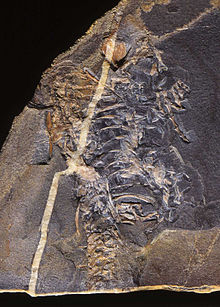
Back Casineria kiddi Catalan Casineria English Casineria French Casineria kiddi Italian Casineria Dutch Casineria kiddi Ukrainian
| Casineria Temporal range: Middle Mississippian
| |
|---|---|

| |
| Casineria kiddi from the Lower Carboniferous of Scotland | |
| Scientific classification | |
| Kingdom: | |
| Phylum: | |
| Subphylum: | |
| Class: | Amniota (uncertain)
|
| Order: | (uncertain)
|
| Genus: | Casineria
|
| Binomial name | |
| Casineria kiddi | |
Casineria was a tetrapod which lived 340 million years ago (mya) in the Mississippian. It was a small animal, length about 15 centimeters.
It lived in what was then a fairly dry environment in what is now Scotland. It had a mosaic of 'basal' (= primitive) amphibian and 'derived' (= advanced) amniote characters.
Casineria was at or very near the origin of the amniotes. It may have been one of the very first true amniotes. The only fossil lacks key elements: most of the skull and the whole lower body is missing. This makes exact analysis difficult.[1]
Casineria was an insectivore. This earliest amniote had five fingers with claws on each hand, and marks the earliest known clawed foot.[2][3]
Its name, Casineria, is a latin version of Cheese Bay, the site near Edinburgh, where it was found.
- ↑ Monastersky R. (1999): Out of the Swamps: how early vertebrates established a foothold—with all 10 toes—on land, Science News 155, #21, p328
- ↑ Cite error: The named reference
naturewas used but no text was provided for refs named (see the help page). - ↑ Alibardi L. 2008. Microscopic analysis of lizard claw morphogenesis and hypothesis on its evolution. Acta Zoologica: Morphology and Evolution, 89 (2): 169–178. abstract